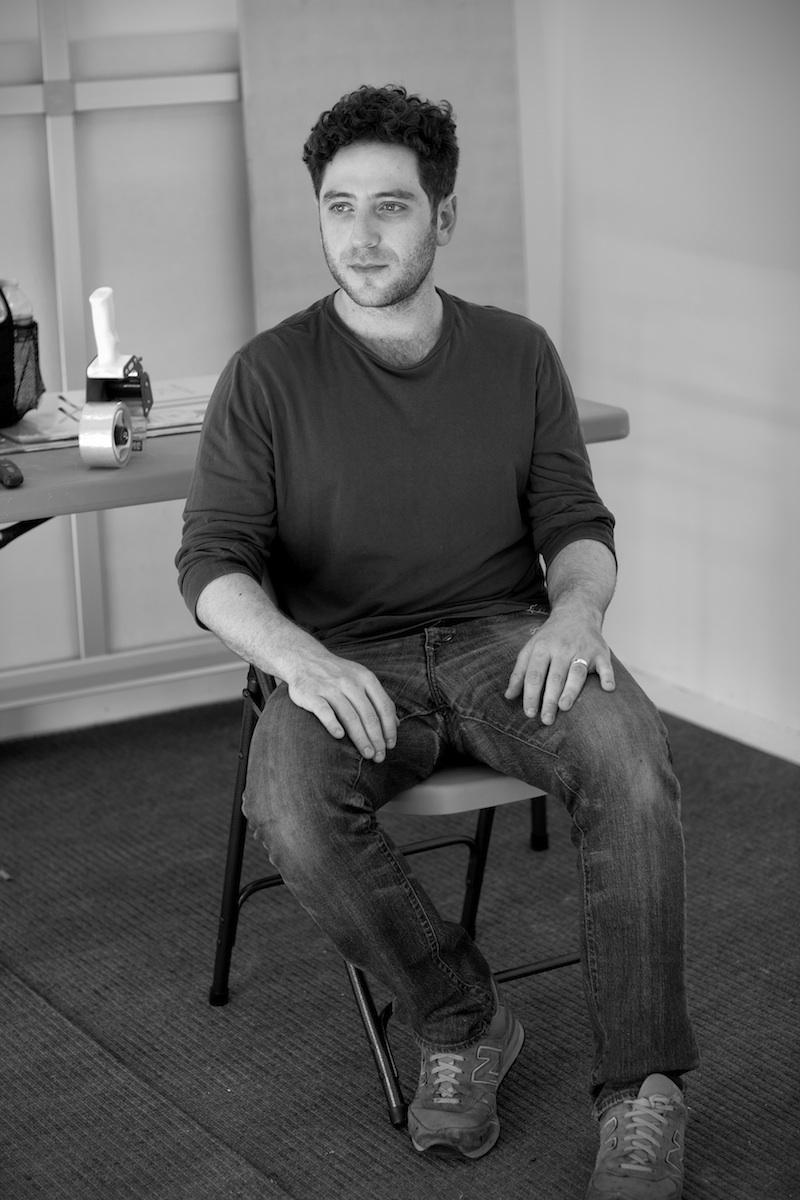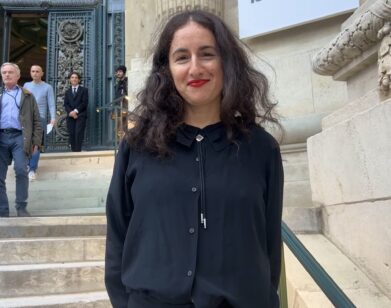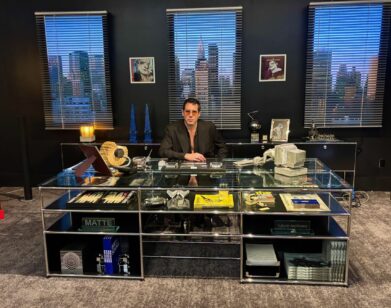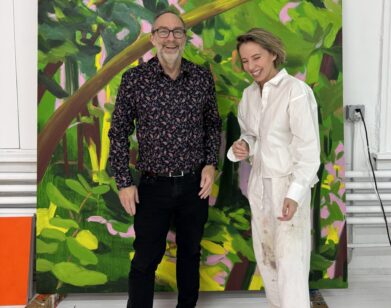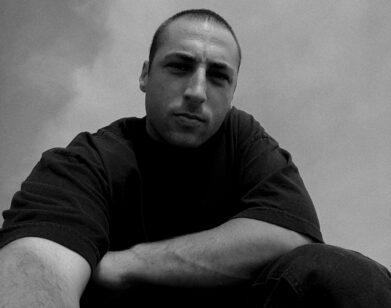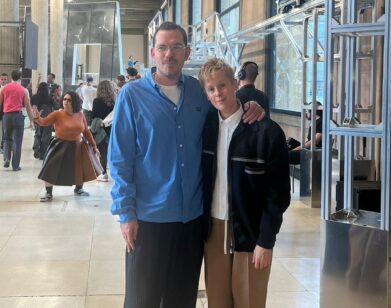Kon Trubkovich’s Transmissions
Kon Trubkovich wants you to read between the lines. He probably wouldn’t mind if you decided to meditate there as well. “Snow,” the Russian born artist’s upcoming exhibit at Marianne Boesky Gallery, features several large-scale portraits frozen in analog static in an ambitious attempt to induce the viewer into a hypnotic state and access elusive memories and deeply entrenched emotions. Though Trubkovich insists that the chosen images on display—himself, his mother, and Ronald Reagan, among others—are inconsequential, it is difficult not to create a Freudian narrative for the artist. The collection also explores Kon’s take on assimilation, abandonment, capitalism, the lasting effects of post-Cold War propaganda, and how these elements build to create a malleable and perhaps suspect personal identity.
The exhibition features a short film, also called Snow. The film evokes immediate comparisons to works by Bruce Nauman and Joseph Beuys, and employs microfilm techniques similarly explored by American experimental filmmaker Ken Jacobs. Trubkovich surpasses his idols by radically transforming VHS footage into dreamlike 35-millimeter celluloid, manipulating each individual frame, creating a thousand unique canvases of nebulous neon light that are hauntingly ethereal and extremely compelling. Together, and in motion, they are something else entirely. Snow’s colorist, Tom Poole, who also served as colorist on Steve McQueen’s 12 Years a Slave and Nicolas Winding Refn’s Drive, is an old comrade of Trubkovich’s. Credit for scoring the film goes to Christopher Taylor and John Greswell of alt-rock band and production team Menlo Park Music.
We caught up with Kon at his studio in Brooklyn to discuss his upcoming show, navigating the fine line between figurative and abstract painting, elements of evolutionary psychology, and the difficulty of capturing a poltergeist in multiple mediums.
KURT MCVEY: You are showing at the Marianne Boesky Gallery. Is there a Russian connection there, so to speak?
KON TRUBKOVICH: No. None whatsoever. It’s not a joint émigré fairytale or whatever. As far as I know, she grew up in Connecticut. [laughs]
MCVEY: [laughs] I do want to talk about Russia a little bit. I thought it was fascinating that a major reason for your family moving to the States was the Chernobyl disaster. How has that affected you and your art, being that your parents were essentially escaping a nuclear meltdown? Were you able to process this as a young person?
TRUBKOVICH: I don’t know how it affected me other than my parents deciding to leave. It’s mostly something I learned about through history books. It might be due to the fact that it was kind of covered up at first, you know. Though, even now I can’t say it’s had any direct effect on my life, only peripherally through my parents’ decision to get out.
MCVEY: You spent much of your teenage years in New York, back in the ’90s. Can you describe your experience at that time and talk about some of the changes that have taken place?
TRUBKOVICH: It was a funny time in New York, kind of a libertine era. Nightlife was very intense with rave, drug, and skate culture—all of these things converging. Then in the mid-’90s, Giuliani came along, and those things started to change and shift, and the city became safer and cleaner. It became geared more towards the wealthy and all those cultures started to fade away. Things have become more prosaic, unfortunately.
MCVEY: Did you always know you wanted to be an artist?
TRUBKOVICH: Being a professional artist, in and of itself, is kind of a total fail. [laughs]
MCVEY: [laughs] Until it isn’t.
TRUBKOVICH: Well, there’s a lot of scrutiny, plenty of tension, some pressure that comes along with that. I was pretty young. I was 26 when I had my very first show at PS1.
MCVEY: Who was the curator?
TRUBKOVICH: Neville Wakefield. He really put me on.
MCVEY: Very cool. How did Neville discover you as an artist?
TRUBKOVICH: Through his babysitter.
MCVEY: Really? How did that happen?
TRUBKOVICH: [laughs] Max Fish. Yeah, I was at Max Fish. There was a show there featuring some artist friends who had also been in a show curated by Neville at Barbara Gladstone [Gallery]. I don’t know why, but I thought I should have been in that show too. I was kind of fixated and I sort of sought Neville out, but instead I just happened to be drunk and talking to my friend Alana Gabin at Max Fish about how I felt left out of this guy’s show, and it turns out she babysat his kids.
MCVEY: No way.
TRUBKOVICH: Yes, among many other things she did, of course. She helped him out from time to time. So she said, I’ll show him some of your work. She showed him, he liked it, called me about a month later, came to the studio, and three months later I was in this show at PS1. Right after that, I signed with Marianne. I’ve been showing with the same gallery for 10 years now.
MCVEY: Such a wonderful story. What’s it like to have a relationship like that with a gallery? Do you ever feel like you have to cater your art to the space, the clientele, or the general aesthetic of the gallery?
TRUBKOVICH: No. Never.
MCVEY: I found this next fact relevant, mostly due to some of the recurring themes in your art, but it was recently brought to my attention that you’re about to become a father.
TRUBKOVICH: Yes, in a matter of weeks. My first kid.
MCVEY: Is there a due date?
TRUBKOVICH: February 28, so hopefully about a week after the show, provided the baby comes on time.
MCVEY: Well, first of all, congratulations.
TRUBKOVICH: Thank you.
MCVEY: You’ve directly referenced your own mother in your work. She’s clearly been a major influence on you.
TRUBKOVICH: Whose mother hasn’t? [laughs] But that’s not what the paintings are about. The “Mom” image is sort of a way in, an avatar for an emotion or a feeling, just a sense of connection to something, anything really.
MCVEY: Is that the most powerful connection between two human beings; a mother and her child?
TRUBKOVICH: I think it’s an uncertain connection. Let’s just say this, and I don’t want to get into evolutionary psychology too much, but I think it’s tenuous at best. Relationships change constantly. The paintings are about the difficulty in actually ascertaining that connection. It’s easy to talk about connection as this physical thing, as having existed in a moment in time, and I mean a really intense feeling of connectedness, it can only ultimately exist as a memory. So the paintings exist as a facsimile of the feeling itself, and if the feeling is elusive, the image becomes elusive.
MCVEY: So the paintings are attempting to express the physicality of memory.
TRUBKOVICH: My mother’s image is a hall pass into that emotion. The same way the Reagan paintings are a hall pass into something that’s quite the opposite, which is the sense of alienation or individualism. They are part of an elaborate self-portrait, in that Reagan represents the male ego and my mother, the female ego. It’s about my way into memory and the inevitable disappearance of it.
MCVEY: Let’s talk about the German psychologist Erich Fromm. In The Art of Loving, he talked about this idea of conditioning or teaching oneself how to love.
TRUBKOVICH: The L.A. show (“Leap Second,” OHWOW, 2012) was very much about that.
MCVEY: How much did that book affect the human relationships outside of your art? Can these things be mutually exclusive?
TRUBKOVICH: I see what you’re saying, but it’s not direct like that. I don’t see these paintings as just being about my personal experience. I truly look at them as part of a collective experience of remembering and forgetting.
MCVEY: What attracts you to analog as opposed to digital?
TRUBKOVICH: This is actually an extremely small part of my project. The technical element just creates another layer, but what attracts me to analog as opposed to digital, is that if you dub, and re-dub, and re-dub a tape, it has its own organic codex that is impossible to pre-determine. You have to submit to the medium, which is in a way similar to painting.
MCVEY: The title of this new show is “Snow.“ You will also be featuring a short film with the same title. How aware are you that a whole generation of young people born into the digital age may miss the dual meaning behind this title?
TRUBKOVICH: Well, for this show, I’ve taken VHS and brought it into film space. In that sense, I’m working with the ultimate analog material, which is not just tape and magnetic signal, but image on celluloid. As you can see, I’m interested in how things change, and how things exist in a very fragile state. It’s not for nostalgia’s sake. I tell stories sometimes about the first time anyone showed me a VHS tape when I was a kid in Moscow, and how fascinated I was that you could rewind it, and fast-forward it, and also record over it. It’s not about some nostalgia for the ’80s.
MCVEY: Well, I hope not.
TRUBKOVICH: [laughs]
MCVEY: Are you looking to directly trigger some kind of memory experience for your audience?
TRUBKOVICH: I cede control on some level, knowing there’s very little I can do to create a response of my own design, but I do consider exhibitions to be emotional spaces, and you have to allow the experience to mutate. The paintings, in some way, because they’re sequential—being one second of footage, meaning 24 frames make up 24 paintings—they create a dynamic physical space that nurtures this process.
MCVEY: How much time and pressure did you put on yourself to find that one perfect second of footage? Did you scroll through miles of tape?
TRUBKOVICH: I looked through hours and hours of footage. I was looking for something that I felt was true. You know? You need some element of truth to the image, because when you pause the tape, something happens. This kind of pathos enters them, a narrative that isn’t perhaps there when you’re watching in real time.
MCVEY: The personal narrative of the viewer?
TRUBKOVICH: Honestly, when it’s playing, that second may look as banal as it gets, like a person briefly looking up, but when you start breaking it apart and slowing it down things begin to appear, and change, and animate in ways that weren’t expected. I look for those things. I like to think that I’m being very honest with what I’m saying and how I feel. When it comes to the direct emotive aspect of the work, I hope I’m not being coy or ironic about any of it.
MCVEY: Which is often the case for many contemporary artists.
TRUBKOVICH: That is what it is. I chose to do it another way. There’s no pre-programmed way out of these paintings. I’m committed to them in a way that may be anachronistic to contemporary art, but it’s strange because I find that to be a very contemporary stance. It’s a paradox, isn’t it?
“KON TRUBKOVICH: SNOW” IS ON VIEW AT MARIANNE BOESKY GALLERY, 509 W. 24TH STREET, FROM FEBRUARY 20 THROUGH MARCH 22.

